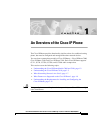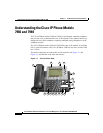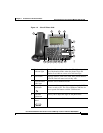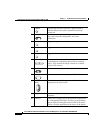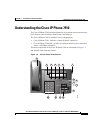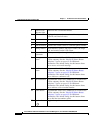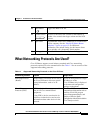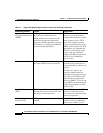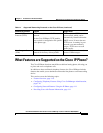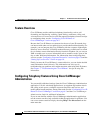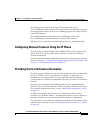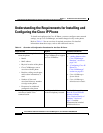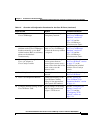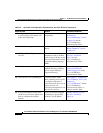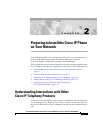
Chapter 1 An Overview of the Cisco IP Phone
What Networking Protocols Are Used?
1-8
Cisco IP Phone Administration Guide for Cisco CallManager 3.2, Cisco IP Phones 7960/7940/7910
78-10453-04
Dynamic Host
Configuration Protocol
(DHCP)
DHCP dynamically allocates and assigns
an IP address to network devices.
DHCP enables you to connect the IP
phone into the network and become
operational without manually assigning
an IP address or configuring additional
required network parameters.
DHCP is enabled by default. If
disabled, you must manually
configure the IP address, subnet
mask, gateway, and an TFTP
server on each phone locally.
Cisco recommends that you use
DHCP custom option 150. With
this method, you configure the
TFTP server IP address as the
option value. For additional
supported DCHP configurations,
see the Cisco CallManager
System Guide.
Internet Protocol (IP) IP is a messaging protocol that addresses
and sends packets across the network.
To communicate using IP,
network devices must have an
assigned IP address, subnet, and
gateway.
IP addresses, subnets, and
gateways identifications are
automatically assigned if you are
using the Cisco IP Phone with
Dynamic Host Configuration
Protocol (DHCP). If you are not
using DHCP, you must manually
assign these properties to each
phone locally.
Real-Time Transport
(RTP)
RTP is a standard for transporting
real-time data, such as interactive voice
and video over data networks.
Cisco IP Phones use the RTP
protocol to send and receive
real-time voice traffic from other
phones and gateways.
Transmission Control
Protocol (TCP)
TCP is a a connection-oriented transport
protocol.
Cisco IP Phones use TCP to
connect to Cisco CallManager
and to access XML services.
Table 1-1 Supported Networking Protocols on the Cisco IP Phone (continued)
Networking Protocol Purpose Usage Notes




